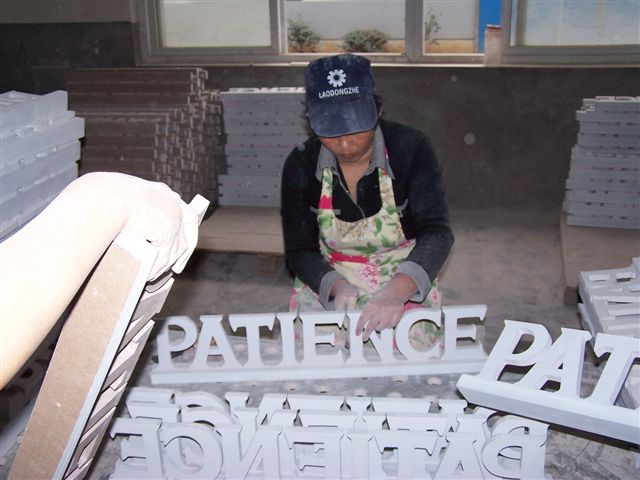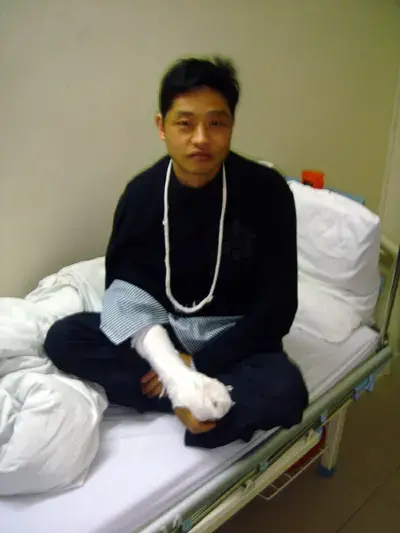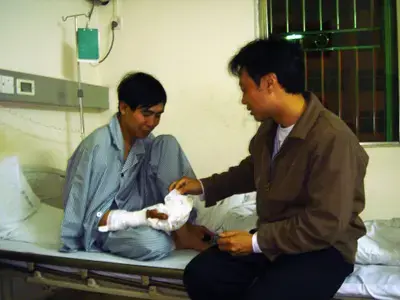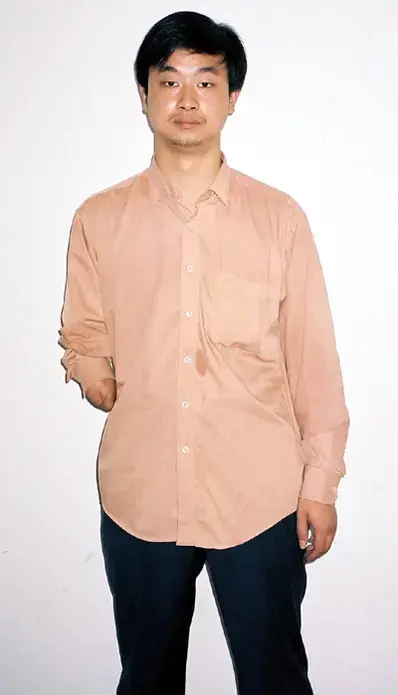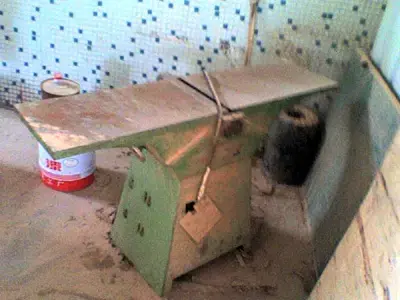Three patients in a room at Shenzhen Renan Hospital share their plight with hundreds of thousands of Chinese workers: They became amputees using outdated, dangerous machines to make goods for America and the world.
Li Xueping, 44, his right hand and arm swathed in thick gauze, lost three fingers making metal kitchen and bathroom accessories for numerous American companies, including Corte Madera, Calif.-based Restoration Hardware, shipping records show.
Ho Yongjiang, 39, lost part of his thumb, and Yu Wanlin, 33, lost part of his left index finger making furniture bound for the U.S.
"I can't grow my finger back," Yu said, "so there really is no compensation."
Machines that mutilate
No official statistics count the number of amputations in China, but millions of Chinese workers have lost legs, arms, hands or fingers since 1995, said Zhou Litai, a lawyer who represents such workers.
In the southern province of Guangdong alone since 1995, at least 360,000 factory workers have lost limbs, said Liu Kaiming of the Institute of Contemporary Observation, a Shenzhen-based think tank.
Throughout China, workers making goods for export use crude machines that lack safety features standard in the U.S. Often, the equipment is discarded industrial machinery from Japan, South Korea and Taiwan, said Garrett Brown, an industrial hygienist from California who reviewed other researchers' reports and inspected numerous large factories in China from 2000 through 2006.
China's 2002 Law on the Prevention and Control of Occupational Diseases orders factories to gradually replace unsafe machines. It is illegal to import or use equipment that may produce "occupational-disease hazards."
But the law is rarely enforced. "Inspections on the factory floor are zippo, and that's the best of the lot," Brown said.
Beijing, which enacted the law, is limited in what it can do because enforcement is left to local governments, added Fu Hualing, a Hong Kong University law professor. "But what is the incentive for local government?"
Interviews with 17 amputees, numerous experts and more than 25 factory visits reveal the following recurring problems:
• Most machines lack safety guards or mechanical systems to prevent workers' hands from touching fast-moving blades and saws.
• Even when machine guards exist, they often are not used because they slow down production.
• Broken or poorly maintained machinery is commonly used despite threats to worker safety.
• Factories often continue using machines that amputate limbs and fingers.
• Workers are expected to work 11-hour days, six or seven days a week. Coupled with use of crude machines, extreme fatigue causes accidents.
'All I could see was blood'
The stories of the three amputees interviewed in the Shenzhen hospital are typical of others throughout China, lawyers for amputees said.
Li Xueping had worked in the Helixing Hardware and Crafts Co. Ltd. factory in Shenzhen for six months when his accident occurred. The factory employs 185 workers who make metal Christmas ornaments, file cabinets, baskets and kitchen and bathroom equipment, according to its Web site. It exports to the U.S. for Globeunion, a Taiwanese company, which also has an office in Wheaton, Ill.
A farmer from Sichuan Province, Li came to this city nine years ago to improve his family's standard of living, leaving his wife and 11-year-old son behind. He consoled himself that the money was worth it: He earned about $200 a month, more than double what he had earned at his previous job in another metal factory.
His accident occurred on March 16. Li took his place at a machine with a round blade that automatically descends and cuts, then rises back in place. His job was to remove each metal towel rack after it had been cut, then put a new uncut metal piece in its place.
The blade descended, cut the metal, and rose. Li inserted his gloved left hand to withdraw the metal when the blade unexpectedly descended again, instantly, automatically.
"I knew my fingers had been amputated," said Li, his dark eyes intense as he told his story from his hospital bed. "I couldn't see them through the glove, all I could see was blood, but when I tried to move my fingers I couldn't feel them. I knew they weren't attached."
In a telephone interview, Xia Shenghuan, a manager at the Helixing factory, said "worker carelessness" caused the accident.
"If you're a little more careful, the accident won't happen," Xia said. "A worker shouldn't put his fingers under the blade."
In the U.S. and most other industrialized countries, such machines must have metal guards to keep workers' fingers away from blades, said Jim Frederick, assistant director of health and safety for the United Steel Workers. "Either there's a guard over the blade, or a tether keeps the worker away, or if you take even one hand off the machine the saw stops," he said. "You wouldn't find a blade like that in a manufacturing setting in this country."
Meanwhile, at the factory, Li yelled for help. A driver took him to the hospital in a factory car. Li sat in the back seat, cradling his bleeding gloved hand.
As he lay on a bed at the hospital, a drape over his hand, a physician cut his glove off. Li heard something fall into a metal container. "My fingers," he said.
A surgeon reattached Li's three fingers, but it's unclear whether he will regain their use, he said.
Now, back at the Helixing factory, Li is on "sick leave" for two months and not expected to work, according to Chinese regulations. His employer must pay him his salary, as well as provide food and his dormitory room.
But Li feels uncomfortable not working, so he is in the factory every day, examining the quality of products and reminding other workers to keep their hands away from saw blades. In mid-May, he said he had not been paid since just before the accident in March.
With the gauze bandages off Li's hand, his three reattached fingers appear swollen, scarred and rough.
"I don't have any feeling in them," he said. "I hope some feeling will come back."
Asked about the unsafe machinery that workers use at the factory that supplies Restoration Hardware, a spokeswoman said the factory apparently was a temporary subcontractor, not one the company ordinarily uses.
Fran Hammond, Restoration Hardware's senior vice-president of global sourcing, said company policy forbids purchasing from overseas factories that have unsafe, unguarded machinery, unless the factory is taking clear steps to get rid of unsafe equipment in six months or less.
"We rely on our agents to do an inspection and auditors to do a compliance program," said Hammond, adding that inspections are based on compliance with local laws and conventions of the Switzerland-based International Labor Organization of which China is a member.
'The finger is useless'
Yu Wanlin, one of Li's two visitors at the hospital, tells a story similar to Li's. He lost part of his left index finger at the Xin Chang factory in Shenzhen while making furniture for U.S. consumers.
Yu met Li at the hospital weeks earlier while visiting Wang Suona, 21, who also worked at the Xin Chang factory. Wang had also lost an index finger using the same machine at the factory that amputated Yu's.
"The surgeon amputated Wang's toe to replace his finger," Yu said, a wide smile spreading across his face. "I told him I couldn't understand why he agreed to that, to suffer pain in two places instead of just one."
Like Li, Yu had come to Shenzhen from rural Sichuan Province hoping to better provide for his parents and 8-year-old daughter. He began working in the furniture factory on Oct. 25, 2004, earning about $200 per month, including overtime. Each month he sent home about $125, which allowed his family to move to a two-story, two-room home. As subsistence farmers, they were able to buy more chickens, as well as seven ducks and five pigs.
Before his accident on Jan. 12, 2006, Yu was feeling sorry for himself. Not only was he exhausted from having worked 15-hour days for 30 days straight, he had not seen his wife in two months. She worked in a shoe factory in the nearby city of Dongguan. "I was thinking I had become a machine," Yu explained.
The table saw Yu used every day had been jerry-rigged. Carpenters once had used the table to sand lumber, but a factory supervisor told Yu he had changed the machine himself.
On the day of the accident, Yu was cutting and fashioning a couch for export to New York.
Yu pushed the lumber into the table saw blade, but it resisted, seemingly stuck on an uneven part of the table. Suddenly, the wood shifted to the left, and Yu took his eyes off the saw as he placed his hand on a different part of the wood to guide it into the saw. "I was just thinking of putting the wood back in the right place. I wasn't thinking about my finger," said Yu, who saw the injury before he felt it: The top third of his index finger was missing.
A co-worker ripped a shirt and fashioned a tourniquet for Yu. The colleague helped him to the street. But no taxi was available. Yu got into a type of three-wheeled vehicle not allowed on main streets, so the ride to Longgang Central Hospital took nearly an hour. Although the physical pain was more severe than any he had ever experienced, the mental pain was worse.
"I wondered if I'd be able to work in a factory again," Yu said. "I wondered how I'd earn money."
Yu's employer paid for Yu's hospitalization and surgery, as required under Chinese law.
After the accident, Yu spent two months living at the three-story concrete factory, without working. Then Yu resumed work for a few months. But he quit, he said, because the owner, Huang Bingseng, twice told him to leave after they argued over back pay that Yu felt he was owed. Contacted by telephone, Huang said he did not clearly remember Yu.
"There are many workers in the factory," Huang said. "Injuries happen but not that much. Sometimes workers are responsible and sometimes it's the machine."
A Shenzhen People's Court judgment dated March 2007 shows the court ordered Huang to pay Yu nearly $1,000 for "losses from industrial injuries." Huang had declined to insure himself against Yu's disability, so he must pay Yu from his own pocket.
The city Labor and Social Welfare Protection Bureau certified Yu's case as an occupational injury, according to a document dated March 6, 2006. Later that month, the city Labor Arbitration Committee decided Yu's injury was a "grade 10."
Injuries are ranked on a scale of 1 to 10, with 10 the least severe. The grade of an injury, as well as a worker's salary, are computed in a formula to determine the worker's disability payment. In the end, Yu gave the money to his parents.
One of the U.S. businesses that imported from the Xin Chang factory while Yu used its primitive equipment was Furniture On Consignment in Omaha, Neb., according to 2005 import documents. Owner Rod Kush said he never had visited the factory in China. He ordered the furniture at the High Point Market in North Carolina, a fair where wholesalers display their furniture. "All the big companies use Chinese factories to make their furniture -- Drexel, La-Z Boy, Thomasville. I don't remember which brands I ordered that time."
Yu has no feeling in the finger that was amputated -- not even in the part of the finger that was not amputated. "The finger is useless," he said. "It's like it isn't there."
He has not found another steady job, although he has had occasional work as a carpenter since the accident. The lack of feeling in his index finger makes him slower and less efficient in handling tools and lumber, he said, perhaps making him less employable. Now, he says, he is lucky to earn an estimated $60 per month. Sometimes, to supplement his unsteady carpenter's income, he offers people rides on his bicycle's back seat for about 25 cents.
'Why should they care about me?'
Li's hospital roommate Ho Yongjiang rested in his bed, quietly watching a police drama on TV. A thick gauze bandage covered his left hand and his arm.
Below his elbow a neat row of stitches binds the wound where a surgeon removed the skin from the fatty part of his arm and used it rebuild a thumb for him, Ho said.
He knew it was dangerous to work in a furniture factory. During his 11 years at the Shenzhen New Nantian Industrial Co. factory, a two-story, 35,000-square-meter building in a sleek industrial park, 30 to 40 of about 60 carpenters in his workshop had lost fingers, hands, arms or parts of arms, he said. Often, the accidents occurred while they used table saws lacking safety devices.
"Things might be better if we had better machines," said Ho, adding that his factory had purchased one table saw with safety guards earlier this year. The nine other table saws still have no guards, he said.
Representatives of companies that buy from New Nantian said they never saw the workers who made their products.
Armen Art Ltd. of North Hollywood, Calif., which wholesales furniture throughout the U.S., received a shipment worth $20,454 from the factory in November 2006. Bob Phillips, an Armen Art sales manager, said he visited the New Nantian factory, but only saw their design room and their finished products. He added he visited three factories a day in China and did not linger at any one factory. Phillips said he was impressed with the factory because "They actually had a forklift. Most forklifts in China are nothing more than 10 guys."
"They had some products we wanted to try," Phillips continued. "We tried it, for about 15-16 months, but it didn't work out. They're not a supplier to us now."
Another company, Nova Metal Co. of New York City, imported $20,974 worth of furniture in May 2005 from New Nantian, according to import documents. Nova Metal's buyer, Joe Dell, said he visited the factory but, "They only showed me the showroom," Dell said. "I brought in a few containers from them, then I stopped."
Ho's accident occurred March 28 when he was using a table saw without a guard to cut lumber for a cabinet. He pushed the lumber toward the saw with his hands. He happened to glance at his right hand and saw blood on his thumb. The top of his thumb was missing.
The factory's driver took Ho to People's Hospital, where he waited for about an hour in electrifying pain, the inch remaining on his thumb bleeding profusely despite Ho squeezing it with his other hand. Then nurses decided not to admit him because "They said it was too serious, I had to go to a different hospital," Ho recalled.
The driver took Ho to Shenzhen Renan Hospital, 20 minutes away, where he was admitted. Just as Ho was feeling calmer, telling himself he'd finally get attention, the X-ray machine suddenly stopped working, nurses told Ho. They suggested he get an X-ray at another hospital.
He ended up back at People's Hospital. "They thought it was strange that I'd want an X-ray, when I wasn't going to have surgery there, so they made we wait," Ho recalled. Finally, nearly four hours after the accident, an X-ray was taken of Ho's thumb. But no one gave him any pain medicine.
Delirious with pain, Ho got back into the car and emerged, again, at Shenzhen Renan Hospital. The driver handed nurses Ho's X-ray. Ho waited. Finally, five hours after Ho's thumb was severed, he was wheeled into an operating room.
"I concluded the hospital is not a good place for people to go," Ho said. "There's no use in being angry. There are so many patients in the hospital, so why should they care about me?
A manager at New Nantian refused to discuss Ho's injury. "He's an ordinary worker," he said, then hung up.
But for the three men in the hospital room, all facing futures as amputees, there is but one reason for their plight: old, outdated machinery.
"I know in developed countries they have better machines, but in my case I can only push the wood with my own hands," said Ho. "Of course it's dangerous."
Click here to view the Salt Lake Tribune's special web version of the "American Imports, Chinese Deaths" series, complete with photos, graphics, articles, and an interactive discussion thread.


